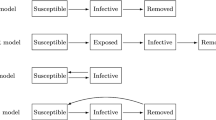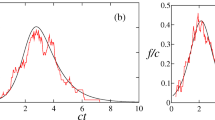Abstract
One of the side-effects of the climate changes that are upon us is that infectious diseases are adapting, evolving and spreading to new geographic regions. It is, therefore, imperious to develop epidemic models that shed light on the interplay between the dynamics of the spread of infectious diseases and the combined effects of various vaccination and prevention regimens. With this in mind, in this work we propose a epidemic model operating on a large population; we restrict our attention to strains of infectious diseases that resist treatment. The time-dependent epidemic accounts, among others, for the effects of improved sanitation, education and vaccination. Our first main contribution is to derive the time-dependent probability mass function of the number of infected individuals in such a system. Our derivation does not use probability generating functions and partial differential equations. Instead, we develop an iterative solution that is conceptually simple and easy to implement. Somewhat surprisingly, the epidemic model also provides insight into various stochastic phenomena noticed in sociology, macroeconomics, marketing, transportation and computer science. Our second main contribution is to show, by extensive simulations, that suitably instantiated, our epidemic model be used to model phenomena describing the adoption of durable consumer goods, the spread of AIDS and the dissemination of mobile worm spread.






Similar content being viewed by others
Notes
This is done mostly for convenience, as we can always make the infection rates distinct by viewing them as ordered pairs of the form (k,λ k ).
References
Anderson RM, May RM (1991) Infectious diseases of humans: dynamics and control. Oxford University Press, Oxford
Arif S, Khalil I, Olariu S (2012) On a versatile stochastic growth model. Int J Comput Intel Syst. doi:10.1080/18756891.2012.696911
Bailey NTJ (1950) A simple stochastic epidemic. Biometrika 37:193–2007
Bailey NTJ (1975) The mathematical theory of infectious diseases and its applications. Haffner, New York
Bass FM (1969) A new product growth for model consumer durables. Manag Sci 15(5):215–227
Becker NG (2005) How does mass immunization affect disease incidence? In: Proc workshop on mathematical modeling of infectious diseases: dynamics and control, Singapore, October
Billings L, Schwartz IB (2002) A unified prediction of computer virus spread in connected networks. Phys Lett A 297:261–262
Boland PJ, Singh H (2003) A birth-process approach to Moranda’s geometric software-reliability model. IEEE Trans Reliab 22(2):168–174
Daley DJ, Gani J (1999) Epidemic modelling: an introduction. Cambridge University Press, Cambridge
Hammond BJ, Tyrrell DAJ (1971) A mathematical model of common-cold epidemics on Tristan da Cunha. J Hyg 69:423
Hethcote HW (2000) The mathematics of infectious diseases. SIAM Rev 42(4):599–652
Mantle J, Tyrrell DAJ (1973) An epidemic of influenza on Tristan da Cunha. J Hyg 71(1):89–95
Kermack WO, McKendrick AG (1927) A contribution to the mathematical theory of epidemics. Proc R Soc Lond A 115(772):700–721
Nicholl KL, Tummers K, Hoyer-Leitzel A, Marsh J, Moynihan M et al (2010) Modeling seasonal influenza outbreak in a closed college campus: impact of pre-season vaccination, in-season vaccination and holidays/breaks. PLoS ONE 5(3):e9548
McInnes CW, Druyts E, Harvard SS, Gilbert M, Tyndall MW, Lima VD, Wood E, Montaner JS, Hogg RS (2009) HIV/AIDS in Vancouver, British Columbia: a growing epidemic. Harm Reduct J 6:5. doi:10.1186/1477-7517-6-5
Murray JD (2003) Mathematical biology: I. An introduction. Springer, Berlin
Nee S (2006) Birth-death models in macroeconomics. Annu Rev Ecol Evol Syst 37:1–17
Yan G, Rizvi S, Olariu S (2010) A time-critical information diffusion model in vehicular ad-hoc networks. In: Proc. ACM MOMM’2010, Paris, France, November
Bulygin Y (2007) Epidemics of mobile worms. In: Proc IEEE international performance, computing, and communications conference (IPCCC 2007), pp 475–478, April. doi:10.1109/PCCC.2007.358929
Acknowledgements
We would like to thank six anonymous referees for their helpful comments that have greatly contributed to improve the presentation of the paper. Last, but certainly not least, we wish to extend our thanks to Professor H. Arabnia for his professional handling of our submission.
Author information
Authors and Affiliations
Corresponding author
Appendix
Appendix
The goal of this appendix is to prove auxiliary results that are used as stepping stones in the previous sections of the work. We begin by proving the following straightforward result.
Lemma 1
If a 1,a 2,…,a n (n≥2) are distinct real numbers then the following identity holds:

Proof
We proceed by induction on n. To settle the basis, observe that

as expected.
For the inductive step, let n (n≥2), be arbitrary and assume that for the chosen value of n, (17) holds. With this assumption, our goal becomes to show that

After multiplying (17) throughout by \(\frac{1}{a_{n+1} - a_{1}}\) and after suitably transposing terms we obtain

With this observation, the left-hand side of (18) becomes

□
A companion result to Lemma 1 goes as follows.
Lemma 2
If a 1,a 2,…,a n (n≥2) are distinct real numbers then the following identity holds:

Proof
We proceed by induction on n. To settle the basis, observe that

as desired.
For the inductive step, let n (n≥2), be arbitrary and assume that for the chosen value of n, (20) holds. With this assumption, our goal becomes to show that

We begin by writing

Recall that by Lemma 1

After multiplying (23) throughout by \(\frac{1}{a_{1}}\) and after suitably transposing terms we obtain

By virtue of (24), (22) can be written as follows:

This completes the proof of Lemma 2. □
Finally, we take note of the following result.
Lemma 3
If a 1,a 2,…,a n (n≥2), are distinct real numbers then the following identity holds:

Proof
We proceed by induction on n. To settle the basis, observe that

as expected.
For the inductive step, let n (n≥2), be arbitrary and assume that for the chosen value of n, (26) holds. With this assumption, our goal becomes to prove that

We write

as desired. This completes the proof of Lemma 3. □
1.1 A.1 The sanity check
The major goal of this section is to prove that for all t≥0, the probabilities P k (t) add up to 1.
Theorem 2
For all t (t≥0)

Proof
By Eq. (15) for t≥0,

Thus, proving Theorem 2 is tantamount to proving the following result.
Lemma 4
Recall that by Theorem 1, for 1<k<N and for t≥0,

For all 1≤i≤N−1, the coefficient of \(e^{- \lambda_{i} t}\) in \(\sum_{k=1}^{N-1} P_{k}(t)\) is

Proof
To begin, assume that 2≤i≤N−1. Straightforward algebra confirms that the coefficient of \(e^{- \lambda_{i} t}\) in \(\sum_{k=1}^{N-1} P_{k}(t)\) is

On the other hand, observe that with the assignment

Lemma 3 guarantees that

Finally, by (29) and (30), combined, the coefficient of \(e^{- \lambda_{i} t}\) in \(\sum_{k=1}^{N-1} P_{k}(t)\) is

completing the proof of Lemma 4. □
In turn, Lemma 4 implies Theorem 2.
Thus, for all t (t≥0),

and the proof is complete. □
Rights and permissions
About this article
Cite this article
Arif, S., Olariu, S. Efficient solution of a stochastic SI epidemic system. J Supercomput 62, 1385–1403 (2012). https://doi.org/10.1007/s11227-012-0802-x
Published:
Issue Date:
DOI: https://doi.org/10.1007/s11227-012-0802-x




